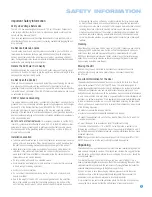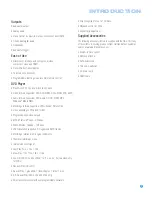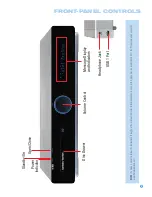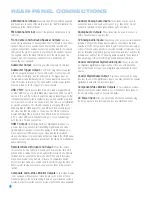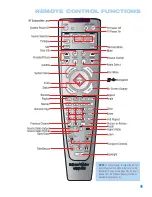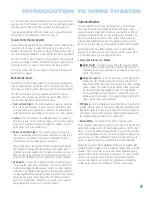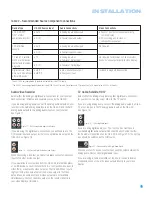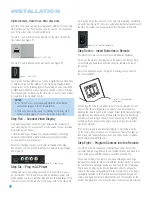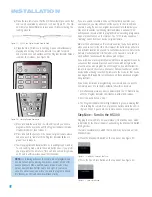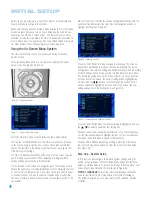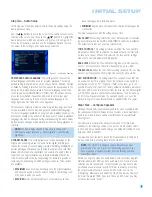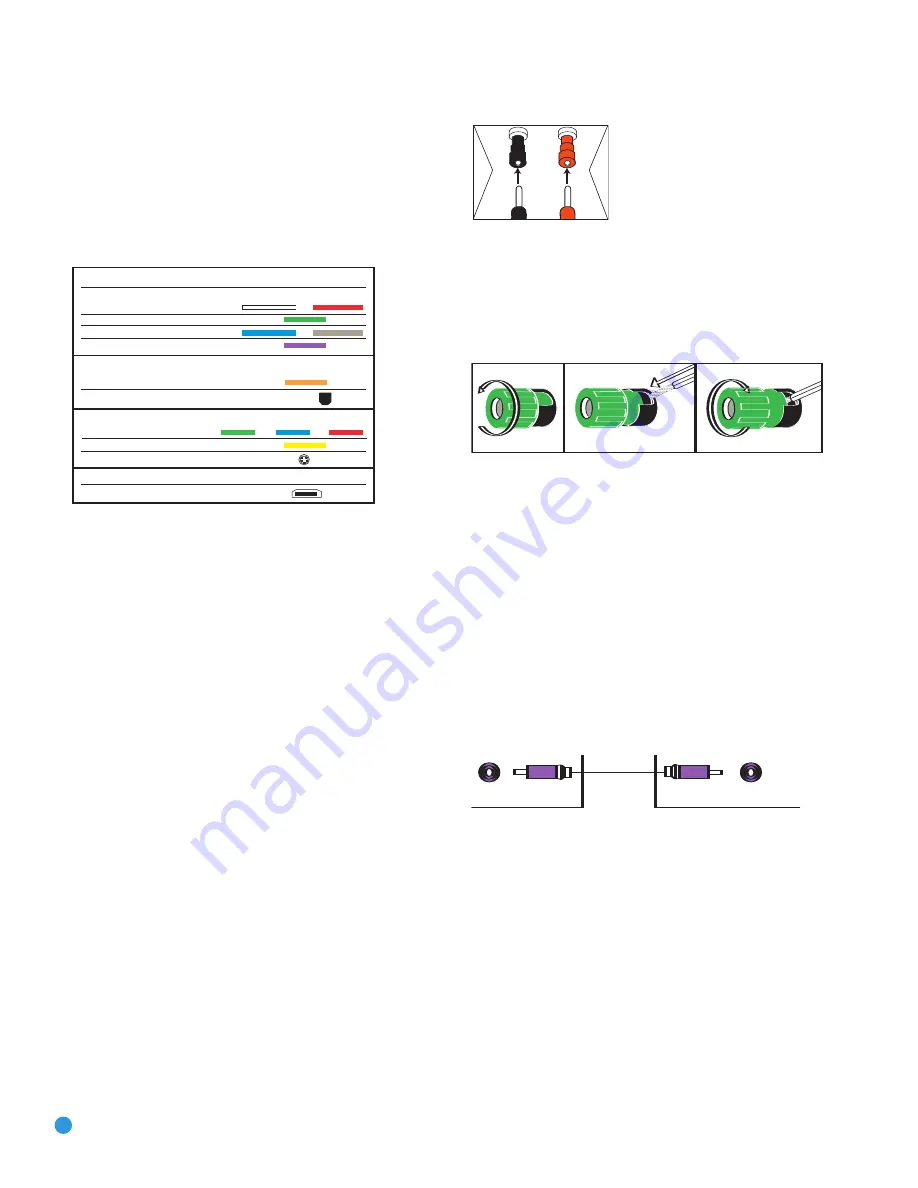
16
CONNECTIONS
There are different types of audio and video connections used to
connect the HS 300 to the speakers and video display, and to connect
any source devices to the HS 300. To make it easier to keep them all
straight, the Consumer Electronics Association (CEA) has established
a color-coding standard. Table 1 may be helpful to you as a reference
while you set up your system.
Table 1 – Connection Color Guide
Types of Connections
This section will briefly review different types of cables and connections
that you may use to set up your system.
Speaker Connections
Speaker cables carry an amplified signal from the receiver’s speaker
terminals to each loudspeaker. Speaker cables generally contain two
wire conductors, or leads, inside plastic insulation. The two conductors
are usually differentiated in some way, by using different colors, or
stripes, or even by adding a ridge to the insulation.
The differentiation is important because each speaker must be
connected to the HS 300’s speaker-output terminals using two wires,
one positive (+) and one negative (–). This is called speaker polarity.
It’s important to maintain the proper polarity for all speakers in the
system. If some speakers have their negative terminals connected to
the HS 300’s positive terminals, performance can suffer, especially for
the low frequencies.
Always connect the positive terminal on the loudspeaker, which is
colored red, to the positive terminal on the HS 300, which is colored
as shown in the Connection Color Guide (Table 1). Similarly, always
connect the black negative terminal on the speaker to the black
negative terminal on the HS 300. The wires in the speaker system
included with your HS 300 Home Theater System are color-coded
with bands.
The HS 300 uses binding-post speaker terminals that can accept
banana plugs or bare-wire cables, should you wish to upgrade your
system in the future.
Banana plugs are simply plugged into the hole in the middle of the
terminal cap. See Figure 1.
Figure 1 – Binding-Post Speaker Terminals With
Banana Plugs
Bare wire cables are installed as follows (see Figure 2):
1. Unscrew the terminal cap until the pass-through hole in the collar
is revealed.
2. Insert the bare end of the wire into the hole.
3. Screw the cap back into place until the wire is held snugly.
Figure 2 – Binding-Post Speaker Terminals With Bare Wires
Subwoofer
The subwoofer is a specialized type of loudspeaker that is usually
connected in a different way. The subwoofer is used to play only the
low frequencies (bass), which require much more power than the other
speaker channels. In order to obtain the best results, the HS 300
includes a powered subwoofer that contains its own amplifier on board.
A line-level (nonamplified) connection is made from the HS 300’s
Subwoofer Output to a corresponding jack on the subwoofer.
See Figure 3.
Although the subwoofer output looks similar to the analog audio jacks
used for the various components, it is filtered and only allows the low
frequencies to pass. Don’t connect this output to your other devices.
Although doing so won’t cause any harm, performance will suffer.
Figure 3 – Subwoofer
Connecting External Source Devices to the
HS 300
The HS 300 is designed to process audio input signals. These signals
originate in what are known as “source devices,” including the internal
DVD/CD player, a DVR (digital video recorder) or other recorder, a tape
deck, a game console, a cable or satellite television box, a flash drive
or an MP3 player. Although the tuner and disc player are built into the
HS 300, they also count as sources, even though no external connec-
tions are needed, other than the FM and AM antennas.
In general, separate connections are required for the audio and
video portions of the signal. The types of connections used depend
upon what’s available on the source device, and for video signals, the
capabilities of your video display.
Subwoofer
Pre-out
Always connect colored (+) terminal on AVR to red (+) terminal
on speaker; and black (–) to black (–).
Branchez toujours la borne (+) colorée sur AVR à la borne (+) rouge sur le haut-parleur;
et la noire (–) à la noire (–).
Conecte siempre el terminal de color (+) en el AVR al terminal rojo (+) en el altavoz;
y el negro (–) al negro (–).
HOW TO USE THE BINDING-POST SPEAKER TERMINAL
COMMENT UTILISER LA BORNE DES HAUT-PARLEURS DE CONNEXION
CÓMO USAR EL TERMINAL DE ALTAVOZ DE POSTE DE SUJECIÓN
Audio Connections
Left Right
Front
(FL/FR)
Center
(C)
Surround
(SL/SR)
Subwoofer
(SUB)
Digital Audio Connections
Coaxial
Optical Output Input
Video Connections
Component
Y Pb Pr
Composite
S-Video
1
2
3
+
Audio Connections
Left Right
Front
(FL/FR)
Center
(C)
Surround
(SL/SR)
Subwoofer
(SUB)
Digital Audio Connections
Coaxial
Optical Input
Video Connections
Component Y Pb Pr
Composite
S-Video
HDMI
™
Connections
HDMI
Summary of Contents for HS 300
Page 1: ...HS 300 INTEGRATED HOME THEATER SYSTEM OWNER S MANUAL...
Page 4: ...4 STAPLE INVOICE HERE...
Page 78: ...78 NOTES...
Page 79: ...79 NOTES...


